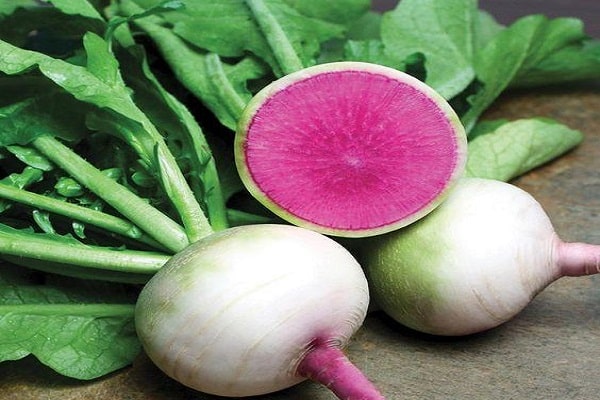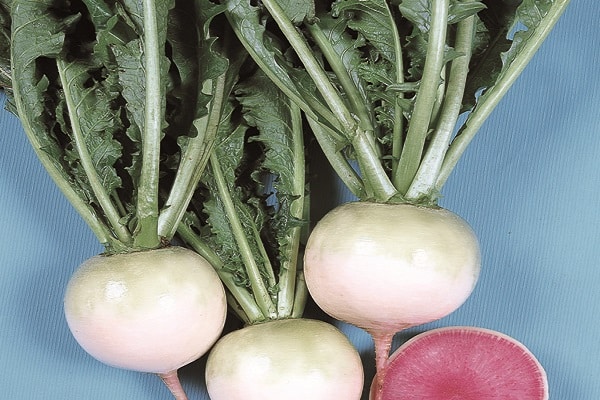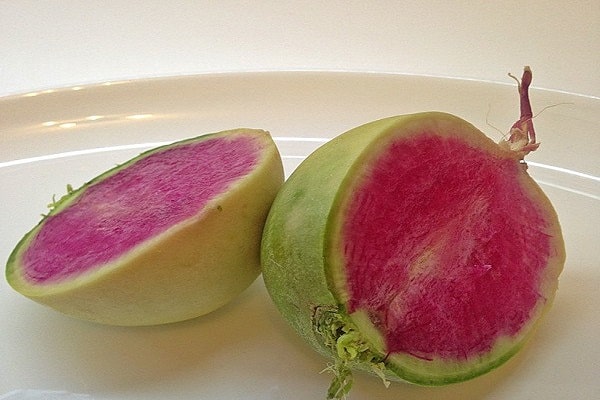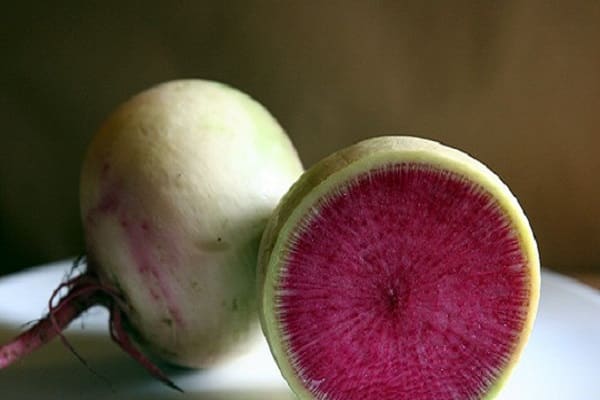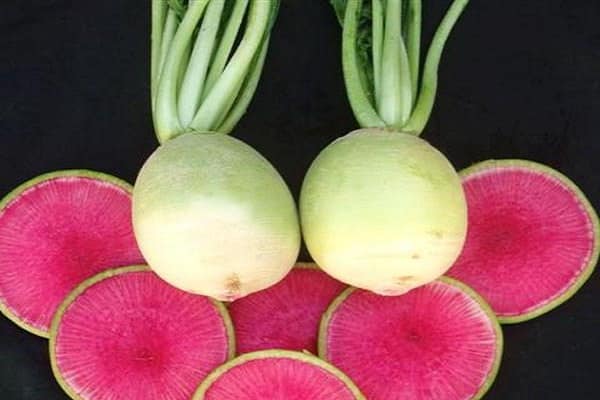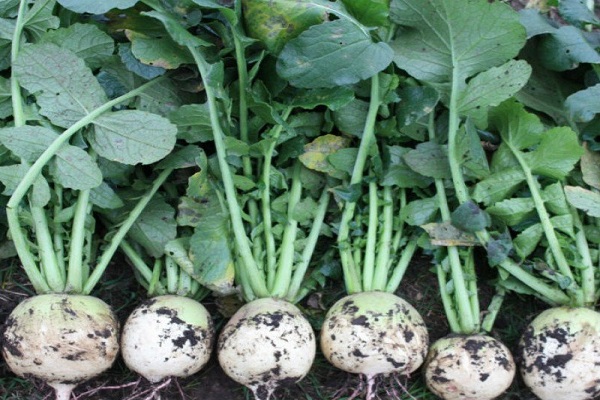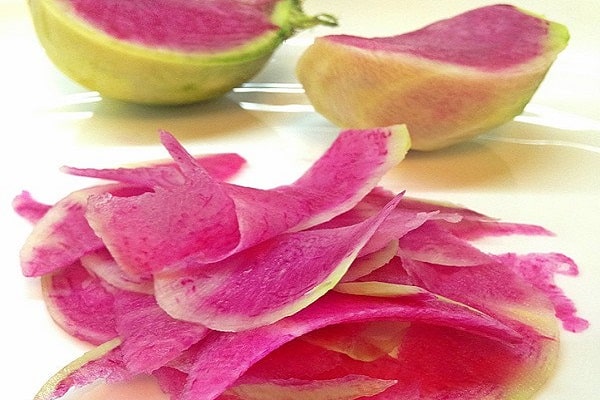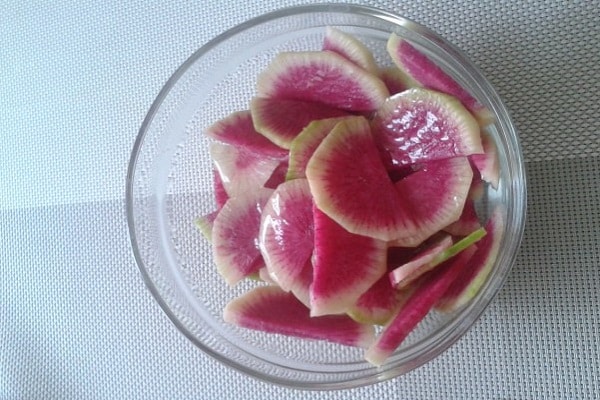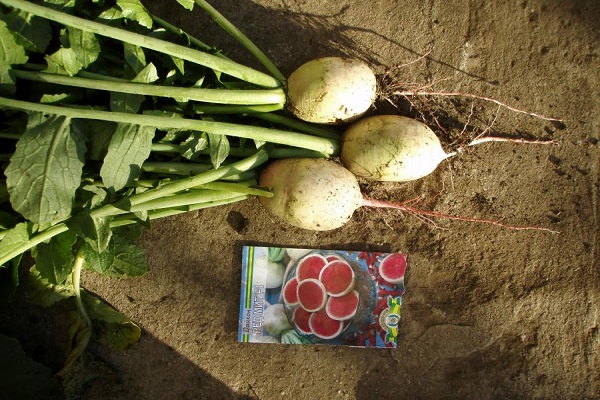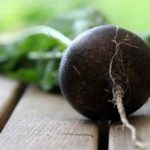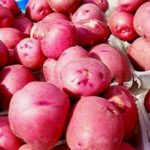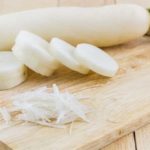The common radish has many varieties. Of these, the Red Meat radish, bred by Japanese breeders, stands out for a number of features. Since ancient times, the root vegetable has been included in the daily diet as a medicinal and prophylactic agent.
Description of the variety
The Red Meat variety is found quite rarely in summer cottages and farms. Despite its low prevalence, the fruits are valued for their juicy, dense white pulp and rich taste.In terms of taste characteristics, the fruits are reminiscent of the Daikon variety and the radish crop of European origin. Regardless of the cooking method, the vegetable is practically not bitter and has common properties with annual radishes.
Red radish is distinguished by large fruits, the weight of which reaches 300 g. The root vegetables have a rounded or cylindrical shape with a thin dark red skin. There are also hybrids with white skin and pink to red flesh.
The top part of the vegetable almost always has a rich green tint.
The root vegetable has a rich composition of vitamins, including beta-carotene, ascorbic acid, thiamine and others. The composition includes macro- and microelements, organic acids and dietary fiber.
Beneficial features
Periodic consumption of the root vegetable helps to have a beneficial effect on the digestive process due to the intake of coarse fibers into the body. Radish improves appetite and promotes accelerated elimination of toxins and harmful substances. The vegetable serves as a prophylactic against cholelithiasis and constipation.
The antibacterial properties of radish allow it to be used for intestinal diseases. For radiculitis and gout, compresses made from radish help, and the juice of the vegetable is rubbed into the skin to combat hair loss. Root tincture is used to remove age spots and freckles. Considering the low calorie content of the product, it is recommended to use it during active weight loss. 100 g of radish contains about 35 kcal.
Benefits and contraindications
Despite the abundance of beneficial characteristics, consuming large quantities of root vegetables can lead to undesirable consequences.In particular, it can cause bloating or irritation of the stomach lining. Contraindications for consuming red radish include:
- The presence of inflammatory processes in the digestive system, including gastric and duodenal ulcers, gastritis, enterocolitis with increased secretory function.
- Some diseases of the kidneys, heart, liver and pancreas.
- Recent heart attack.
- Individual intolerance and allergy to the product.
Growing and care
The culture does not require special growing conditions and careful care. Root crops can grow even on clay-type soil when planted shallowly. But a rich harvest can only be obtained on fertile soil with the use of organic fertilizers. It is best to start planting after legumes, winter grains and early potatoes. The crop can be sown in late spring or summer.
Before planting, you should prepare the soil - dig it up, add fertilizer (compost or humus) and add slaked lime if the soil is highly acidic.
After sowing, the soil needs to be watered generously and mulched. During the process of ripening seedlings, it is necessary to constantly remove weeds from the beds, ensure stable watering and fertilize the soil with ammonium nitrate, potassium salt and superphosphate. Manure should not be used as a fertilizer, as it increases the likelihood of plant disease.
Seedlings develop best at temperatures from 15 to 18 degrees. The Red Meat variety is considered cold-resistant and can tolerate light frosts. It is important to remember that temperature changes can lead to a reduction in yield.
Pests and diseases
All varieties of radish belong to the cruciferous family and the pests and diseases inherent in this family are dangerous for the vegetable.The most common disease is blackleg, which can affect both the planted plant and the seeds. When the disease occurs, the plant stem becomes thinner and a constriction forms on it. The reasons for this are waterlogging, the presence of residues from other plants in the soil and sudden temperature changes. The way to combat blackleg is to disinfect the soil with a bleach solution.
If the stem darkens and the leaves fall off, the plant is likely to be affected by fusarium. With this disease, distortion of the fruits and further death may occur. To avoid crop loss, regular watering is required, especially in hot weather.
In addition to diseases, various pests can spoil the radish harvest. The most common insects are red flea beetles, cabbage whites and leaf beetles. To eliminate pests, it is necessary to spray the plants with insecticides and fertilize the soil in a timely manner.
Harvest and storage
Grown plants need to be collected before the onset of frost. As a rule, collection occurs in September. If you want to store the fruits, you need to carefully dig them out of the ground so as not to damage the thin shell and prevent subsequent rotting.
You can store the harvest in a cellar, basement or refrigerator, subject to certain conditions. The suitable storage temperature for Red Meat radish is about 0 degrees, humidity is 85–90%. If root crops remain indoors for the winter, then groundwater and melted snow should not enter the storage.
Use in cooking
Most often, red radish is consumed fresh. The vegetable serves as the basis for preparing various salads.Chopped root vegetables are also suitable for use in vegetable and meat dishes. By adding radish, other foods are absorbed by the body many times faster, and the dish itself acquires a special taste and spicy aroma.
To prepare red radish salad, you can use the simplest recipe. The radish must be thoroughly washed, peeled and grated. Add cabbage, onion and corn chopped into thin strips. In a separate container, mix the sauce from oil, cilantro and apple cider vinegar. Just pour the prepared dressing over the salad and mix.
When serving fatty hot dishes, you can make a salad with chicken liver as an addition. It is better to grate the root vegetable or cut it into pieces, and boil the liver until soft. To taste, you can add onions, oil and spices to the salad.
Lovers of sweet summer salads will love this recipe with the addition of grapes. In addition to it, in combination with root vegetables, you can mix boiled potatoes and celery.
And summer residents who grow other plants in their garden beds may be interested in a recipe for a salad with peas and radishes. The method of preparing it is simple - the root vegetable needs to be peeled and grated, then kept in cold water for 15–20 minutes to eliminate excess bitterness. Add onion and green peas cut into rings to the vegetable, pour in sunflower oil, salt and mix.
During the period of fasting and for those who adhere to a strict diet, a salad recipe with rice is suitable. The dish itself includes boiled rice, red radish, carrots, herbs and an apple. To prepare, you need to finely chop the ingredients and season with a low-calorie sauce. You can add boiled eggs to the salad to suit your taste.
Traditional treatment recipes
The healing properties of Red Meat radish allow it to be used for various diseases, including colds and sore throats. In addition, the juice of the root vegetable can eliminate bacteria and heal external ulcers and wounds. Phytoncides in the vegetable have a positive effect on the body’s protective properties and increase immunity.
Thanks to a number of vitamins, red radish cleanses the intestines and dissolves small stones in the kidneys and gall bladder. This is a valuable product for stabilizing the functioning of the digestive system and the human body as a whole. Periodic consumption of root vegetables improves food absorption and removes toxins.

